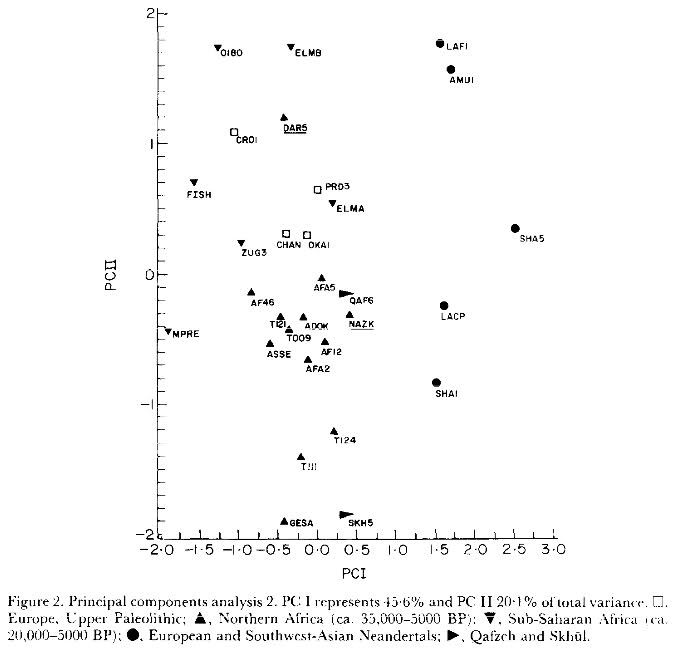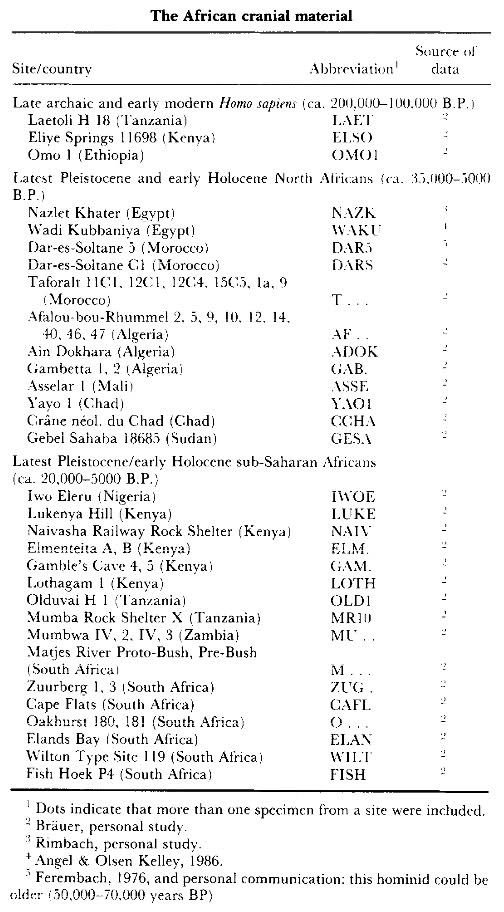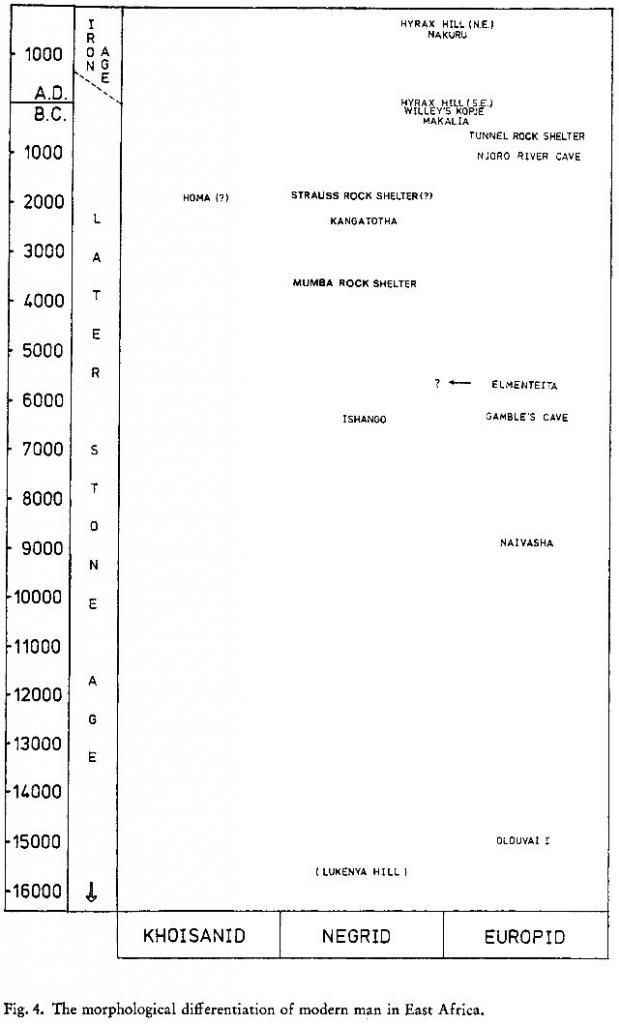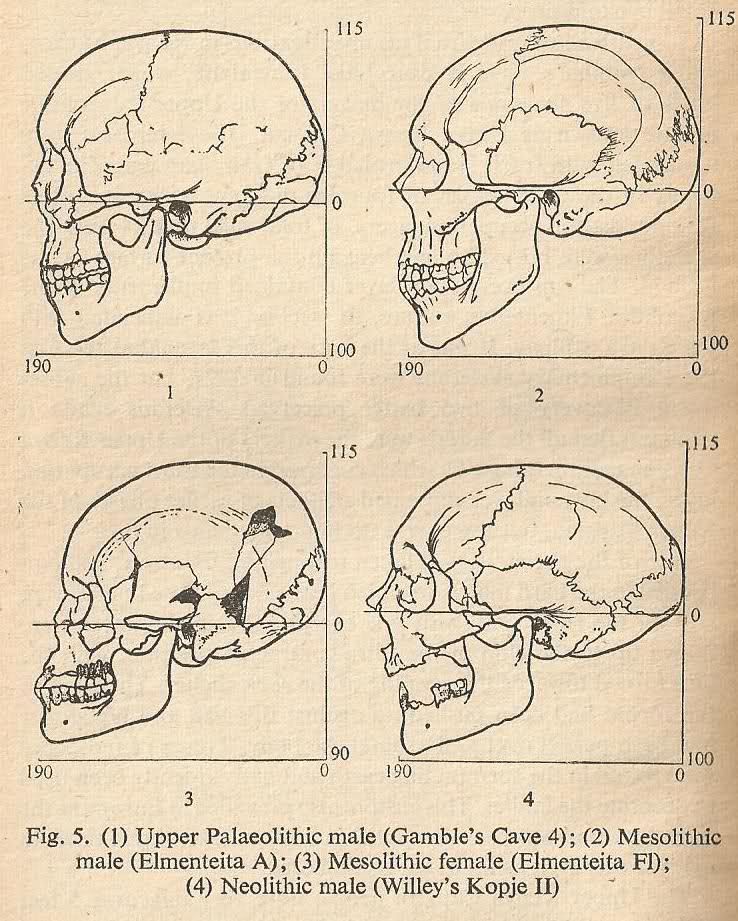see dienekes http://dienekes.blogspot.de/2004/09/racial-affinities-of-prehistoric-east.html
Origin of Caucasoids in Eastafrica:Coon thought the distribution of races in Africa was like before Caucasoids entered the continent from the north (via the Sinai or an Iberian land-bridge) and displaced the indigenous Capoids and Congoids towards the south. Other authorities suggest that the Caucasoids actually entered from the south, through the Bab el-Mandeb. Still others propose that they evolved locally. Sonia Mary Cole takes into account all possibilities(See below).
G. Bräuer conducted a comprehensive study in 1990 where he compared the East and North African Caucasoid crania with other specimens from the continent. He also cross-analysed key skeletal finds from West Asia and Europe. The results were consistent with Sonia Mary Cole's observations(see below) since the Capsian/Eburran fossils and the later Elmenteitan ones generally clustered with his various Cro-Magnon samples, except to some extent for the Elmenteitan B skull due to some Khoisanoid admixture.Origin of Caucasoids in Eastafrica:Coon thought the distribution of races in Africa was like before Caucasoids entered the continent from the north (via the Sinai or an Iberian land-bridge) and displaced the indigenous Capoids and Congoids towards the south. Other authorities suggest that the Caucasoids actually entered from the south, through the Bab el-Mandeb. Still others propose that they evolved locally. Sonia Mary Cole takes into account all possibilities(See below).
He also found that the East African Gamble's Cave and related skeletal material grouped nearest to certain prehistoric Caucasoid remains from West Eurasia. They weren't Negroid, though some Negroid and Khoisan specimens did also coexist in the region during various periods (similar to the situation in prehistoric North Africa).
For example, in the Principal Component analysis below showing the main dimensions of the facial skeleton and other frontal measurements, note the proximity of the Elmenteitan A (ELMA) specimen to the Piedmosti 3 (PRD3), Oberkassel 1 (OKA1) and Chancelade 1 (CHAN) Upper Paleolithic European crania. Most of this clustering is also on the horizontal PCI axis, where 45.6% of the total genetic variance is contained.
That's what Sonia Mary Cole was alluding to when she wrote that the East and North African fossils closely resembled other prehistoric Caucasoid crania from West Eurasia; their culture did too.
"Before leaving Upper Palaeolithic man in East Africa, we should glance briefly at his contemporaries in Europe living during the last glacial period. The Upper Palaeolithic people who invaded Europe after the first phase of the Wurm glaciation arrived in a series of waves, probably from the direction of Palestine. First came the Combe Capelle type, makers of the Chatelperronian culture (which is similar to the Upper Kenya Capsian and to the later Capsian of North Africa). These are the earliest known representatives of Homo sapiens in Europe, apart from the Swanscombe and Fontechevade fossils. They were followed by the Aurignacians of Grimaldi and then by the robust Cro-Magnons, associated with Aurignacian and Gravettian industries. In the Cro-Magnons, Coon sees an admixture of Neanderthal blood, possibly springing from crosses as may have occurred at Mount Carmel. The Cro-Magnons are divisible into a dolichocephalic eastern or Predmost type (which is very close to Combe Capelle), and a broad-headed western type, the Cro-Magnons proper. After them came the Magdalenians known from Chancelade. All these different types may have arrived in Europe within a few thousand years.Here are the fossil specimen codes in Brauer's scattergram above:
The skulls from Gamble's Cave, the Naivasha rock shelter, and Olduvai are very similar to the large-brained Combe Capelle type. Cro-Magnon man is less modern in appearance than the earlier Combe Capelle people; he resembles the 'Mechta' type of North Africa. The conclusion is that Upper Palaeolithic peoples in Africa differed hardly at all in appearance (or in the form of implements that some of them made), from their counterparts in Europe."
Below are Brauer's overall classifications of the pre-historic crania in East Africa, taken from another study (http://www.ncbi.nlm.nih.gov/pubmed/113948)where he discusses the various specimens in greater depth. The Elmenteitan material, though generally classified as Caucasoid/Europid, has a question mark near it because of the Khosanoid admixture that's evident in the short-faced, brachycephalic F1 fossil which Cole described and which is pictured in the OP:
"There is a third African major race: the Mediterranean. The populations living on the shores of the Mediterranean Sea and in parts of East Africa are classified as Mediterranean or Afro-Mediterranean because of their relatively homogeneous Europid characteristics. Due to various admixtures with neighbouring Negrid populations in prehistoric and historic times, the present populations of East Africa in particular are more or less heterogeneous in appearance, especially with regard to soft-tissue morphology[...]
The Mediterranean character is clearly dominant among the Ethiopids, who include the large populations of the Amhara, the Galla and the Somali. Their skeletal features are predominantly Europid; the nose is generally narrow and prominent. However, there are also Negrid admixtures of varying degrees among the individual tribes. The Negrid character is strongest among the Sidamos in South West Ethiopia, and at its weakest among the Somali (Cole 1965)[...]
The number of sites in Algeria and Morocco belonging to the Ibero-Maurusian culture is relatively large. Especially well-known is the mesolithic cemetary of Afalou-bou-Rhummel on the Algerian coast, where in 1928-30 remains of more than 40 adults and a number of children were excavated (Arambourg 1929; Arambourg et al. 1934; Vallois 1952). Likewise linked with the Ibero-Maurusian culture is the important skeletal series of more than 280 individuals found in the Taforalt cave (Morocco) in 1951-1953 (Ferembach 1962). A late Pleistocene layer of this site has been dated to about 10,000-12,000 B.P. (Roche 1959).
In Maghreb, however, there are also numerous settlements of the North African Capsian, which are linked with huge shell mounds. The most important site of this type is Mechta-el-Arbi, southwest of Constantine (Algeria), where in 1907-1927 remains of more than 30 individuals were found in a huge shell mound (Arambourg et al. 1934). As an indication of the dating, the absolute age of another shell mound associated with the same culture (Upper Capsian) may be of interest; it has been dated at about 8,400 + or - 400 B. P., the beginning of the Holocene (Ivanova 1972). The skeletons from Dar-es-Soltan near Rabat (Morocco) also are ascribed to the Mechta type (Vallois 1951; Ferembach 1976).
The morphological affinities of all of these samples are generally Europid, though there appears to have been differentiation into two morphotypes. One is represented by tall, robust individuals with large, long and high crania, broad faces with low, rectangular sloping orbitae and heavy rugged jaws with strong chins (Briggs 1955; Ferembach 1962). The other type comprises individuals with small faces and less rugged "leptodolichomorphic" characteristics. Although both combinations of characteristics do not generally occur separately, relating to the sites, there is some evidence of a tendency (Schwidetzky 1970) for the more robust type to be more numerous in Ibero-Maurusian sites, while the leptodolichomorphic form is more frequent in those of the Capsian, as shown by the East African men of the Kenya Capsian.
The modern populations, too, can be understood on the basis of this polarity of types. The Berber populations from the Maghreb and North West Africa tend to be more robust and broad-faced than the Arabian populations and other groups from the East.
The present Egyptians are closer to the pole of the small leptodolichomorphic Mediterranean populations (Schwidetzky 1970), as evidenced by the populations of Egypt since predynastic times, and have yielded some larger series. However, Egypt had been infiltrated by groups of various populations, especially in historical times.The increase of Negrid influence is due primarily to the Arabic slave-trade. Nevertheless, Negrid influences in ancient Egypt seem to have been much smaller than in Nubia (Strouhal 1975). The present southern Nubians are tall and lightly built, but the skin colour is darker; they are probably the product of hybridization between Europid Egyptians and Negroids."
Only certain of the Mesolithic Elmenteitan skeletal remains in East Africa show some Khoisanoid affinities. The earlier Capsian/Eburran specimens from Gamble's Cave and elsewhere generally do not. This is because admixture between these early West Eurasian/Caucasoid migrants to the region and the local Paleoafricans (perhaps best represented by the Kanjera skull of Kenya) only really began in earnest later, during the Elmenteitan period.
Below are faithful reproductions of the Capsian/Eburran and Elmenteitan crania, taken from Sonia Mary Cole's seminal The Prehistory of East Africa:
Here is the phylogeny of the various skeletal remains, and below it, a map of the fossil sites:





